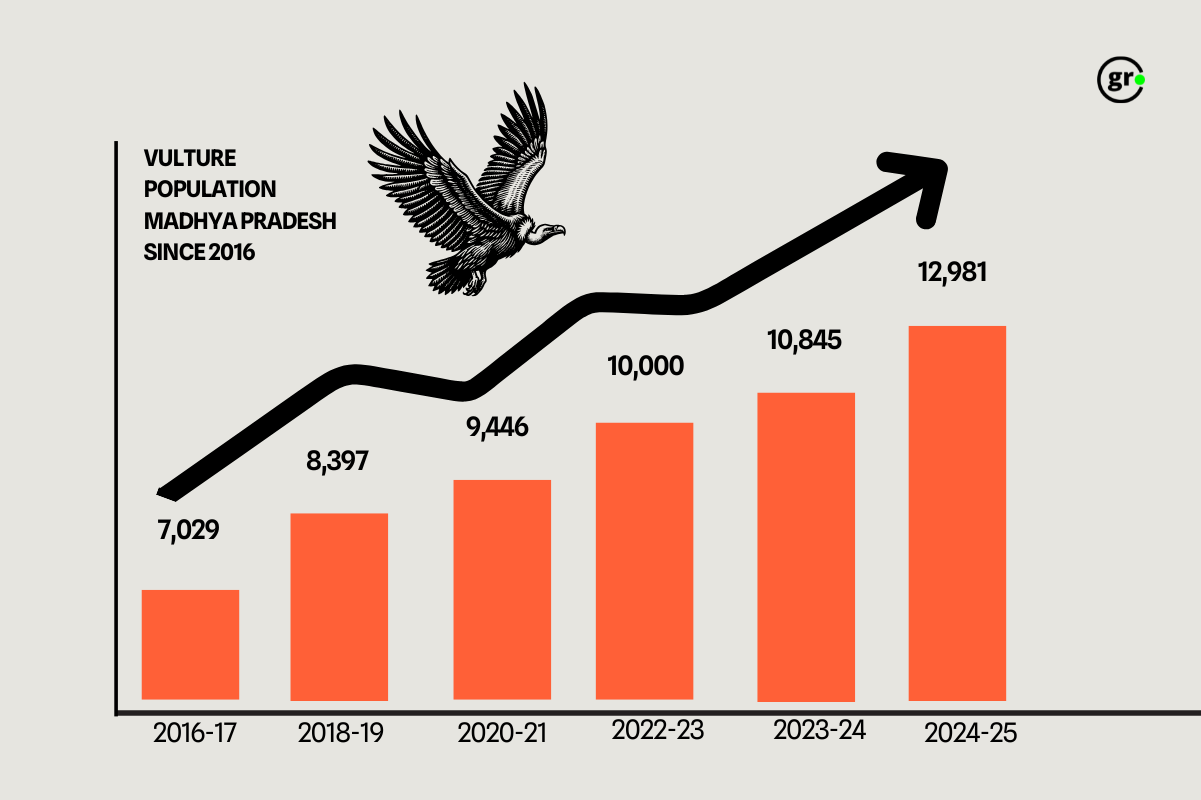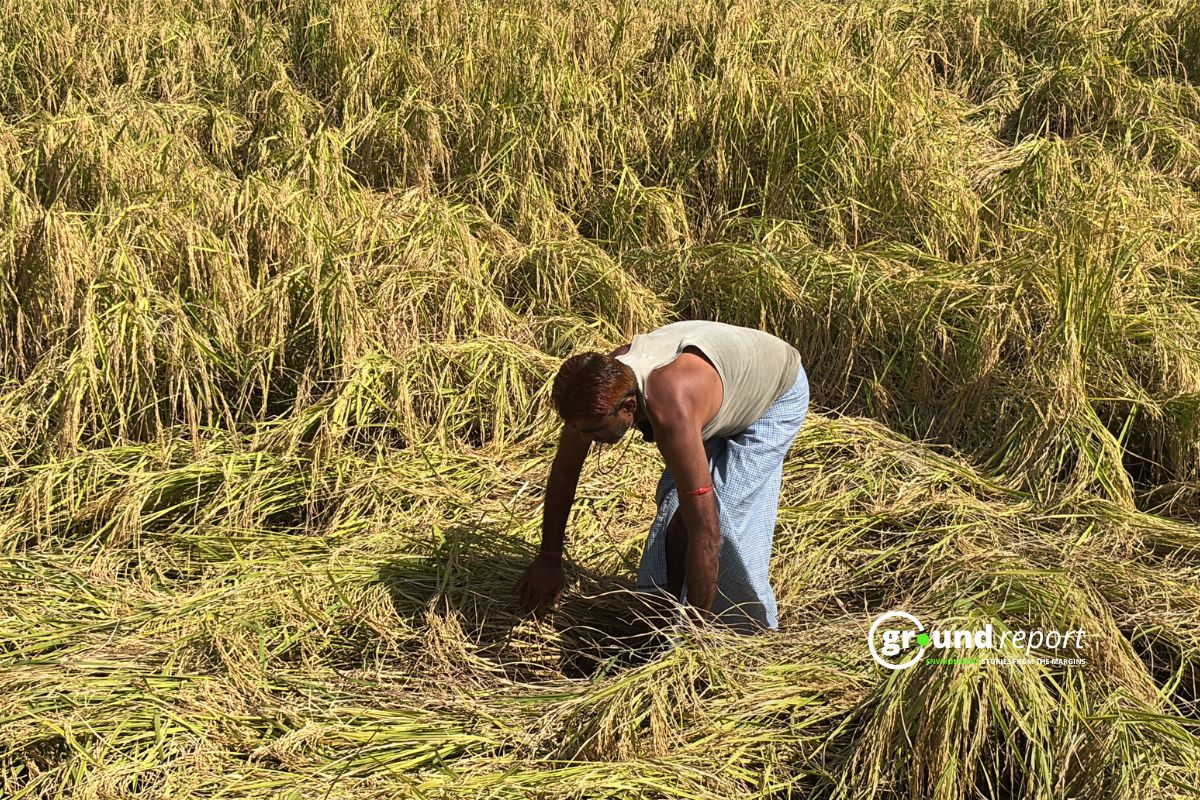With the title of ‘Tiger State’ for having the highest tiger population and ‘Cheetah State’ for the cheetahs reintroduced in Kuno National Park, Madhya Pradesh has now earned the tag of ‘Vulture State’ for having the largest population of this avian species in the country.
According to the recent vulture census, Madhya Pradesh now has more than 12 thousand vultures, which is the highest in the country. Ecologists highlight that the presence of vultures in substantial numbers is a key indicator of ecological health. The big birds play a crucial role as scavengers, swiftly consuming animal carcasses and preventing the spread of diseases. A decline in their population can lead to serious environmental consequences.
Mother nature has its own cleaning mechanism and vultures are a crucial part of this system. When animals die, their bodies start decomposing, allowing bacteria to grow. These bacteria can cause new diseases that may spread to humans. Without enough vultures to clean up carcasses, stray dogs often take their place, leading to an increase in their population. For example, in areas where vulture numbers have declined, there has been a rise in stray dogs, which can spread diseases like rabies.
Species of vultures in MP
Seven species of vultures fly in Madhya Pradesh, out of which four are Indian and three are migratory. Indian species include the white-rumped vulture, Indian vulture, red-headed vulture and Egyptian vulture. The migratory species of vultures in Madhya Pradesh are the Eurasian Griffon, Cinereous Vulture, and Himalyan Griffon.
According to the IUCN Red List of Threatened Species, three Indian vulture varieties—the white-rumped vulture, Indian vulture and red-headed vulture—are critically endangered, while Egyptian vultures are endangered. Among the migratory species, the Eurasian griffon is of least concern, while the other two—the Cinereous Vulture and the Himalayan Griffon—are in the category of near threatened.
Counted twice
The Madhya Pradesh Forest Department has been continuously conducting the census of vultures since 2016. This work is done twice a year by the forest department. The first count takes place at the end of the winter season, in which Indian vulture species as well as exotic species are counted. This time is favourable for the counting of foreign species because foreign species migrate during this time.
The second time is during summer. In this count, baby vultures are counted. In fact, vultures lay their eggs in the winter and hatch their young in the summer. In this way, we get the complete data of vultures in a particular state.
In Madhya Pradesh, this year the winter count has been done between February 17 and 19 and the summer count has been fixed for April 29.
MP is home to around 12,000 vultures
Just last week, a 3-day vulture census was completed in Madhya Pradesh. The results of this count put the number of vultures in Madhya Pradesh at 12,981, including Indian and migratory vultures. This number makes Madhya Pradesh the state with the highest number of vultures in the country.
Last week, vultures were counted in 16 forest circles, 64 divisions and 9 protected forest areas of Madhya Pradesh. Madhya Pradesh Forest Department, along with the Wildlife Institute of India (WII) and other volunteers, had also participated in this task.
In the first phase of the vulture census of 2025, it was taken care that only vultures sitting near their habitats would be counted, not flying vultures. The reason for this is that during counting in a large area, if we count flying and sitting vultures, there is a risk of duplication, as well as the accuracy of the calculation is affected.
A total of 12,981 vultures have been found in Madhya Pradesh in the year 2025 count, which is about 85 percent more than the number of 2016. There were 7,029 vultures in Madhya Pradesh in 2016. This time the number of vultures in the state is 2136 more than the previous count (2023-24).

Significantly, this year the number of vultures has seen an increase of about 19 percent annually. This is the highest annual growth so far. Though there has been a steady increase in the number of vultures in the state since 2016, the rate was the lowest at just 2 percent in 2021-22.
In fact, this increased number of vultures in the state is a positive sign in terms of ecology and biodiversity. But if we look closely at these figures region-wise, some concerns also come to the fore. For example, if we look at the results of the census in Chhindwara, a total of 116 vultures have been found there. This year the number of vultures in Chhindwara has increased by 35 vultures. But what is worrying is that not a single vulture has been sighted in the Chhindwara southern forest division. It is noteworthy that last year also the vulture was not seen here.
Vultures are the cleaners of the environment
If a region has a better population of vultures, it is a clear indication that the ecology and food web is in safe hands. The avain variety are efficient scavengers of the environment that prevent the spread of diseases by feeding on carcasses of livestock, recycling nutrients, and limiting the access of contaminants from soil and water to soil and water. For example, griffon vultures eat a large amount of meat from the carcasses of animals, thereby facilitating the transfer of energy through the food web.
According to the information available on the website of the Vulture Conservation Foundation, the vulture can eat a dead cow in 40 minutes. At the same time, when the population of vultures starts decreasing, dogs and rats do this work. The acidity of the vulture’s stomach is high, which helps in digesting it quickly. At the same time, dogs and rats take more time to wipe the meat. On the other hand, as their population increases, the incidence of diseases and dog bites also increases. The data on the website shows that as the population of vultures declined after 1996, the sale of rabies vaccines increased on the other side.
An article published in The Economist discusses the catastrophic decline of vulture populations in India during the mid-1990s and its severe repercussions on human health. The widespread use of the veterinary drug diclofenac led to acute kidney failure and eventually death in vultures that consumed treated livestock carcasses, causing their numbers to plummet by over 97 percent. This sharp decline disrupted the natural disposal of animal remains, leading to an increase in rotting carcasses. Consequently, there was a significant rise in feral dog populations, which fed on these remains and became primary carriers of rabies. The surge in rabies cases resulted in thousands of additional human deaths. This situation underscores the critical role vultures play in maintaining ecological balance and public health.
Vultures have been a part of our Indian mythology and culture, where in the ancient Hindu scriptures the bird has been referred to as Jatayu. The bird is revered in Ramayana for sacrificing his life trying to save Sita, wife of Rama from Ravana, symbolizing duty and righteousness. The most famous temple dedicated to Jatayu in India is the Jatayu Earth Center (Jatayu Nature Park) in Kerala. It is one of the world’s largest bird sculpture (200 feet long, 150 feet wide, and 70 feet high), towering over the town of Chadayamangalam in Kollam district.
Despite the bird’s strong connection with India’s ethos, vultures became victims of human medicinal mistakes primarily due to the use of diclofenac, a painkiller given to cattle. This unintended consequence led to a catastrophic decline in vulture populations.Drugs diclofenac, aceclofenac, ketoprofen, and Nemocid used for cattle proved fatal for vultures. It impacted their kidneys. Diclofenac was banned on July 5, 2008. All four drugs were banned for veterinary use. Aceclofenac and ketoprofen were banned on 31 July 2023. Nemocid was banned on 30 December 2024.
Even though these drugs are banned, they are still available in the market. Many people, including pharmacists, farmers, veterinarians, cow vigilantes, and the general public, are unaware of how harmful these painkillers are to vultures. It is important to stop using them immediately. A safer alternative, Milasike Vulture Medicine, is now available, which is beneficial for animals.
Edited by Diwash Gahatraj
Support us to keep independent environmental journalism alive in India.
Keep Reading
Erratic rainfall: Orange farmers and traders suffer in Pandhurna
Wadda Mal’s water woes: Families fight for survival amid crisis
Chhindwara’s maize-ethanol dream: promise vs reality
Soil Health Card: Ambitious scheme faces ground-level challenges
Follow Ground Report on X, Instagram and Facebook for environmental and underreported stories from the margins. Give us feedback on our email id greport2018@gmail.com.
Don’t forget to Subscribe to our weekly newsletter, Join our community on WhatsApp, and Follow our YouTube Channel for video stories










